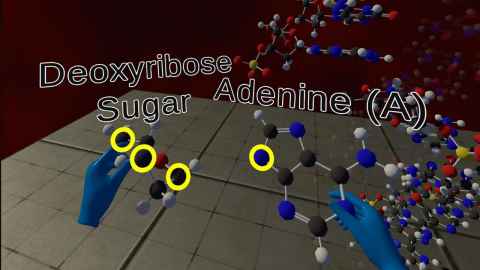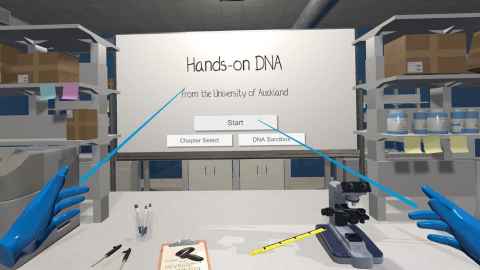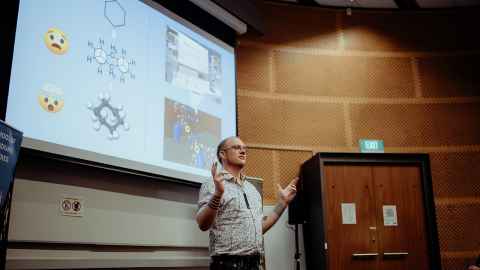Pulling apart DNA: learning molecular biology through a VR lens
29 October 2021
Sebastian Dunn is a Science Masters student working with the School of Biological Sciences and the School of Computer Science.

Science is difficult. And it moves quickly. Each new generation of scientists enters an increasingly complex world, and they need to learn more information more quickly than ever before. This creates a constant need for innovation in science teaching. Luckily, it also creates new technologies we can explore to help solve this problem.
When I first learned biochemistry, molecules were stick figures on a textbook page. They were static and 2D, and electrons were dots that moved along arrows between them. From these pictures, and experience, I had to mentally create a model of the dynamic, 3D world of biomolecules. Every student needs a version of this model in their head if they want to succeed in biochemistry, and the challenge of creating it can vary hugely from student to student.
The other big advantage of VR is it’s fun. It’s new. It’s exciting and engaging. And it turns out it’s a great way to get people interested in science too.
The goal of my research is to lower this barrier, helping other students reach this threshold of understanding more quickly. For my Masters in Science (Bioinformatics), I’m working with the School of Biological Sciences and the School of Computer Science to create a virtual reality experience that teaches students about DNA.
Virtual Reality, or VR, lets us create interactive, 3D scenes that progress through time. It’s a powerful way to teach students how molecules interact, and how those interactions are governed by their 3D structure.

In the VR experience I’ve created, the student starts in a biology lab and then shrinks (from their perspective) all the way down to subatomic size. They end up in the nucleus of a cell where they find a stretch of DNA they can pick up, pull apart, and put back together again. The purpose is to give the student an intuitive sense of the scale of DNA, and then help them learn how the 3D structure of DNA leads to its function as an information storage molecule.
The other big advantage of VR is it’s fun. It’s new. It’s exciting and engaging. And it turns out it’s a great way to get people interested in science too. Working on this project at the University of Auckland has given me the opportunity to incorporate outreach activities into my Masters.
I’ve made a version of my experience that doesn’t need any prior DNA knowledge, where you can smash up the piece of DNA with a baseball bat and learn about the different subunits. We’ve shown it at the Rotary National Science and Technology Forum, the MOTAT STEM Fair, and school outreach events. It’s a big hit with young people and stimulates a lot of conversation about DNA and science.

My project is a transdisciplinary effort that uses lessons from molecular biology, computer science, and pedagogy. The direct purpose of this project is to create better educational tools for the next generation of biologists, but the long term goal is to discover the best ways to use VR to teach.
VR is a new medium that we’ve only just begun to explore properly. I want to uncover the hidden strengths of VR for education, and help future students learn complex concepts that I took years to fully understand.
Written by Sebastian Dunn.
inSCight
This article appears in the 2021 edition of inSCight, the print magazine for Faculty of Science alumni. View more articles from inSCight.
Contact inSCight.